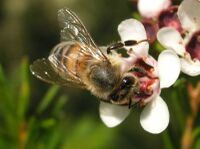Honeybee
- "I caught a honeybee! Hello, honey!" —Wild World
The Honeybee (ミツバチ, Mitsubachi) is a small insect that can be found buzzing around flowers, sometimes settling on them. They are very common, but should not be confused with the Wasp (referred to as the Bee prior to Animal Crossing: New Horizons), a closely-related species that is found in trees. An important difference from the Wasp is that they do not sting the player.
Catch details
In Wild World
| Description | The stinger of a honeybee is actually connected to its internal organs, eh wot? When it uses its stinger... the organs get pulled out. What an abhorrent image! I'm terribly sorry, but nature is not always family friendly! |
|---|---|
| Time of year | Mar – Sep |
| Time of day | 9 AM – 4 PM |
| Peak times | Mar – Jul |
| Location | Flying near flowers |
| Bug size | 13 mm |
| Rarity | Common |
| Selling price | |
| Furniture size |
In City Folk
| Description | All worker bees are female. Their honey has an almost indefinite shelf life. |
|---|---|
| Time of year | Mar – Jul |
| Time of day | Mar – Jun: 8 AM - 5 PM Jul: 8 AM – 4 PM |
| Peak times | N/A |
| Location | Flying near flowers |
| Bug size | 13 mm |
| Rarity | Uncommon |
| Selling price | |
| Furniture size |
In New Leaf
| Time of year | Mar - Jul |
|---|---|
| Time of day | Mar - Jun: 8 AM - 5 PM Jul: 8 AM - 4 PM |
| Peak times | N/A |
| Location | Flying near flowers |
| Size | 16 mm |
| Rarity | Common |
| Selling price | |
| Furniture size |
In New Horizons
| Time of year | North: Mar – Jul South: Sep – Jan |
|---|---|
| Time of day | 8 AM – 5 PM |
| Location | Flying near flowers |
| Weather | Any except rain |
| Spawn requirement | Appears from the start of the game |
| Selling prices | |
| Furniture size |
Donating to the museum
As with all insects in the Animal Crossing series, the Honeybee can be donated to the museum followed by a small talk by Blathers, the curator.
In Wild World
The curator of the museum, Blathers, will accept the Honeybee as a donation to the insect exhibit. He will talk about the Honeybee briefly before accepting it:
The Honeybee can be found at the middle-left side of the first room of the bugs section, on the flowers.
In City Folk
Blathers will talk about the Honeybee with disgust again in City Folk-
It can be found in the lower-left section of the exhibit, buzzing the roses.
In New Leaf
Upon being donated, the Honeybee can be found in the first room of the bug exhibit flying around and resting on the bushes near the back of the room. The exhibit has this to say about the Honeybee:
In New Horizons
Once donated to the museum, the Honeybee can be found on the tropical flower bed near the Man-Faced Stink Bug and the Mantis.
Real-world information
Apis mellifera, the European honeybee, is a species of honeybee that is used frequently around the world to produce honey. There are many subspecies of this bee due to human intervention. This breed of honeybee originated from Africa. Like the in-game wasp and most species of bee, the European honeybee is capable of delivering a venomous sting, though this does not occur in-game. Unlike these other species, the European honeybee's stinger is barbed, causing the bee to fatally disembowel itself when the stinger is caught in the target's skin, leaving behind a sac that continues to envenomate the target until the stinger is removed. Despite being omnivorous, the European honeybee preys on microbes rather than other insects; consequently, stinging is used exclusively to protect against perceived threats.
The European honeybee has been subject to Colony Collapse Disorder (CCD), an unexplained phenomenon in which all worker bees leave their colony and die, leaving the hive without any means of supporting itself.
Names in other languages
| ミツバチ mitsubachi |
Honeybee | |
| 꿀벌 kkulbeol |
Honeybee | |
| 蜜蜂 mìfēng |
Honeybee | |
| Восковая пчела Voskovaya pchela |
Asiatic honeybee | |
| Honingbij | Honeybee | |
| Honigbiene | Honeybee | |
| Abeja melífera | Honeybee | |
| Abeille naine | Dwarf bee | |
| Ape operaia | Literally worker bee, honeybee | |
| Bugs | ||||||||||||||||||||||||||
|---|---|---|---|---|---|---|---|---|---|---|---|---|---|---|---|---|---|---|---|---|---|---|---|---|---|---|
| ||||||||||||||||||||||||||





